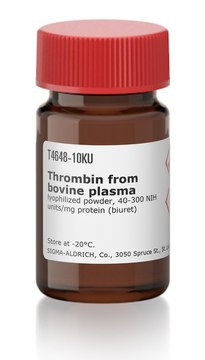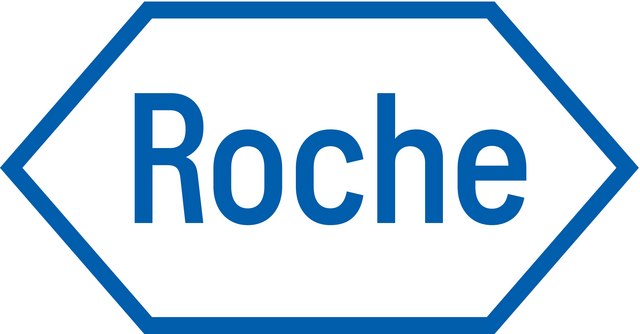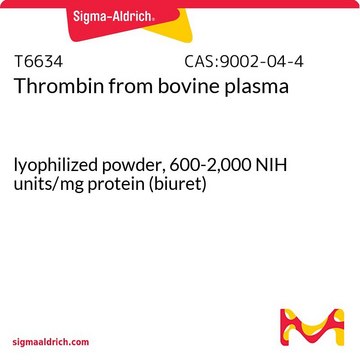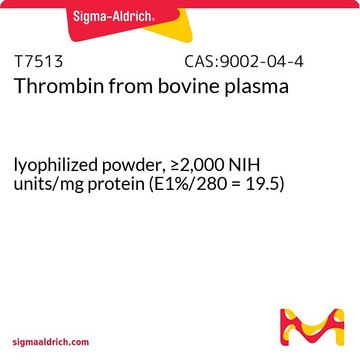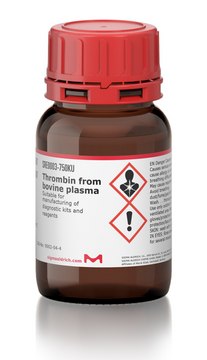T4393
Thrombin from human plasma
lyophilized powder, 1500-3500 NIH units/mg protein (E1%/280, 18.3), suitable for cell culture
Synonym(s):
Factor IIa
Sign Into View Organizational & Contract Pricing
All Photos(1)
About This Item
Recommended Products
biological source
human plasma
Quality Level
sterility
sterile
form
lyophilized powder
specific activity
1500-3500 NIH units/mg protein (E1%/280, 18.3)
technique(s)
cell culture | mammalian: suitable
impurities
HIV, hepatitis B and hepatitis C, tested negative
UniProt accession no.
storage temp.
−20°C
Gene Information
human ... F2(2147)
Looking for similar products? Visit Product Comparison Guide
General description
Thrombin is produced from the proteolytic cleavage of inactive prothrombin in the liver. The prothrombin gene is mapped to human chromosome 11p11.2. It comprises of A and B catalytic domain, recognition domain and insertion loops. The active site residues comprise the catalytic tetrad, (histidine 57, aspartate 102, serine 195 and serine 214).
Application
Thrombin from human plasma has been used:
- as a medium supplement for the pre-treatment of endothelial cell culture prior to confocal microscopy and enzyme linked immunosorbent assay (ELISA)
- in the gelatinization of mesenchymal stem cells (MSCs) for preparing fibrin–MSC construct
- for screening serine protease inhibitor, OGTI from frog skin secretion
Biochem/physiol Actions
Serine protease that selectively cleaves Arg-Gly bonds in fibrinogen to form fibrin and fibrinopeptides A and B.
The main function of thrombin is the cleavage of fibrinogen to fibrin, to assist stable clot formation. High levels of thrombin elicit neurotoxicity in dopaminergic neurons and contributes to the progression of Parkinson′s disease. A wide range of mutations in the prothrombin gene contributes to its deficiency resulting in coagulation disorders like dysprothrombinemia and hypoprothrombinemia. Altered thrombin levels modulates the coagulation pathway in multiple sclerosis. Patients with coronary artery disease (CAD) show elevated levels of thrombin. Thrombin accumulation in neurofibrillary tangles in the brain may contribute to the aggregation of τ protein and pathophysiology of Alzheimer disease.
Unit Definition
Activity is expressed in NIH units obtained by direct comparison to a NIH Thrombin Reference Standard
Reconstitution
When reconstituted with 1 mL water, vial contains stated activity in 0.15 M sodium chloride and 0.05 M sodium citrate, pH 6.5.
Analysis Note
The NIH assay procedure uses 0.2 ml diluted plasma (1:1 with saline) as a substrate and 0.1ml of thrombin sample (stabilized in a 1% buffered albumin solution) based on a modification of the method of Biggs. Only clotting times in the range of 15-25 seconds are used for determining thrombin concentrations.
Disclaimer
RESEARCH USE ONLY. This product is regulated in France when intended to be used for scientific purposes, including for import and export activities (Article L 1211-1 paragraph 2 of the Public Health Code). The purchaser (i.e. enduser) is required to obtain an import authorization from the France Ministry of Research referred in the Article L1245-5-1 II. of Public Health Code. By ordering this product, you are confirming that you have obtained the proper import authorization.
inhibitor
Product No.
Description
Pricing
Signal Word
Danger
Hazard Statements
Precautionary Statements
Hazard Classifications
Resp. Sens. 1
Storage Class Code
10 - Combustible liquids
WGK
WGK 3
Flash Point(F)
Not applicable
Flash Point(C)
Not applicable
Choose from one of the most recent versions:
Already Own This Product?
Find documentation for the products that you have recently purchased in the Document Library.
Customers Also Viewed
Our team of scientists has experience in all areas of research including Life Science, Material Science, Chemical Synthesis, Chromatography, Analytical and many others.
Contact Technical Service
